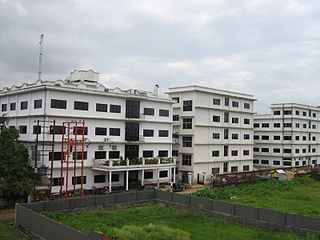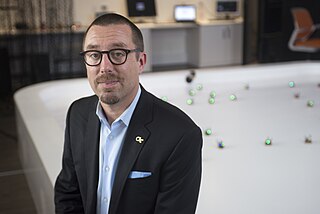
Thomas Shi-Tao Huang was a Chinese-born American computer scientist, electrical engineer, and writer. He was a researcher and professor emeritus at the University of Illinois at Urbana-Champaign (UIUC). Huang was one of the leading figures in computer vision, pattern recognition and human computer interaction.

Ian F. Akyildiz received his BS, MS, and PhD degrees in Electrical and Computer Engineering from the University of Erlangen-Nürnberg, Germany, in 1978, 1981 and 1984, respectively. Currently, he is the President and CTO of the Truva Inc. since March 1989. He retired from the School of Electrical and Computer Engineering (ECE) at Georgia Tech in 2021 after almost 35 years service as Ken Byers Chair Professor in Telecommunications and Chair of the Telecom group.

Meghnad Saha Institute of Technology is a private college located in West Bengal, India. The college is located in the eastern suburb of the city at Nazirabad, Rajpur Sonarpur. The college is approved by the AICTE and the Directorate of Technical Education, and is affiliated with Maulana Abul Kalam Azad University of Technology.

Magnus B. Egerstedt is a Swedish-American roboticist who is the Dean of the Henry Samueli School of Engineering at the University of California, Irvine. He was formerly the Steve C. Chaddick School Chair and Professor at the School of Electrical and Computer Engineering, Georgia Institute of Technology.
Richard W. Ziolkowski is an American electrical engineer and academician, who was the president of the IEEE Antennas and Propagation Society (2005), and a former vice president of this same society (2004). In 2006, he became an OSA Fellow. He is also an IEEE Fellow. He was born on November 22, 1952, in Warsaw, New York.
Raj Mittra is an Indian-born electrical engineer and academician. He is currently a professor of electrical engineering at University of Central Florida. Previously, he was a faculty member at University of Illinois at Urbana–Champaign and Pennsylvania State University, where he was the director of the Electromagnetic Communication Laboratory of the Electrical Engineering department. His specialities include computational electromagnetics and communication antenna design.
John Patrick Hayes is an Irish-American computer scientist and electrical engineer, the Claude E. Shannon Chair of Engineering Science at the University of Michigan. He supervised over 35 doctoral students, coauthored seven books and over 340 peer-reviewed publications. His Erdös number is 2.
Masakatsu G. Fujie is a Japanese scientist who has played a major role in cutting-edge research in biomedical engineering. He has been responsible for many advances in the field of robotics.

Eby G. Friedman is an electrical engineer, and Distinguished Professor of Electrical and Computer Engineering at the University of Rochester. Friedman is also a visiting professor at the Technion - Israel Institute of Technology. He is a Senior Fulbright Fellow and a Fellow of the IEEE.
Robert Tienwen Chien was an American computer scientist concerned largely with research in information theory, fault-tolerance, and artificial intelligence (AI), director of the Coordinated Science Laboratory (CSL) at the University of Illinois at Urbana–Champaign, and known for his invention of the Chien search and seminal contributions to the PMC model in system level fault diagnosis.
Mangalore Anantha Pai was an Indian electrical engineer, academic and a Professor Emeritus at the University of Illinois at Urbana–Champaign. A former professor of electrical engineering at the Indian Institute of Technology, Kanpur, he is known for his contributions in the fields of power stability, power grids, large scale power system analysis, system security and optimal control of nuclear reactors and he has published 8 books and several articles. Pai is the first India born scientist to be awarded a PhD in Electrical Engineering from the University of California, Berkeley.

David Atienza Alonso is a Spanish/Swiss scientist in the disciplines of computer and electrical engineering. His research focuses on hardware‐software co‐design and management for energy‐efficient and thermal-aware computing systems, always starting from a system‐level perspective to the actual electronic design. He is a full professor of electrical and computer engineering at the Swiss Federal Institute of Technology in Lausanne (EPFL) and the head of the Embedded Systems Laboratory (ESL). He is an IEEE Fellow (2016), and an ACM Fellow (2022).

Pamela Cosman is a professor of Electrical and Computer Engineering at the University of California, San Diego. She has conducted a pioneering research on the quality of compressed images for application in medical diagnostic imaging. At UCSD, Cosman currently researches ways to improve wireless video transmission.

Daniel W. Bliss is an American professor, engineer, and physicist. He is a Fellow of the IEEE and was awarded the IEEE Warren D. White award for outstanding technical advances in the art of radar engineering in 2021 for his contributions to MIMO radar, Multiple-Function Sensing and Communications Systems, and Novel Small-Scale Radar Applications. He is a professor in the School of Electrical, Computer and Energy Engineering at Arizona State University. He is also the director of the Center for Wireless Information Systems and Computational Architecture (WISCA).
Lawrence Pileggi is the Coraluppi Head and Tanoto Professor of Electrical and Computer Engineering at Carnegie Mellon University. He is a specialist in the automation of integrated circuits, and developing software tools for the optimization of power grids. Pileggi's research has been cited thousands of times in engineering papers.

Lesley Shannon is a Canadian professor who is Chair for the Computer Engineering Option in the School of Engineering Science at Simon Fraser University. She is also the current NSERC Chair for Women in Science and Engineering for BC and Yukon. Shannon's chair operates the Westcoast Women in Engineering, Science and Technology (WWEST) program to promote equity, diversity and inclusion in STEM.

Edl Schamiloglu is an American physicist, electrical engineer, pulsed power expert, inventor, and distinguished professor in the department of electrical and computer engineering at the University of New Mexico. He has been known in public media for his expertise in the design and operation of directed-energy weapons. He is also known for his assessment on the possible origins of alleged health damages presumably caused on U.S. embassy personnel in Cuba in 2016 as part of the Havana syndrome incident. He is the associate dean for research and innovation at the UNM School of Engineering, where he has been a faculty since 1988, and where he is also special assistant to the provost for laboratory relations. He is also the founding director of the recently launched UNM Directed Energy Center. Schamiloglu is a book author and co-editor, and has received numerous awards for his academic achievements. He is a Fellow of the Institute of Electrical and Electronics Engineers and the American Physical Society.
Krishnendu Chakrabarty is an Indian-American electrical and computer engineer. He is the Fulton Professor of Microelectronics at Arizona State University Ira A. Fulton Schools of Engineering. Before joining Arizona State, he was the John Cocke Distinguished Professor and was the Chair of the Department of Electrical and Computer Engineering at Duke University Pratt School of Engineering.
Akira Ishimaru is a Japanese-American electrical engineer and professor emeritus at Department of Electrical and Computer Engineering at University of Washington. He is best known for his contributions to the theory of wave scattering in random media.
Chin-Hui Lee is an information scientist, best known for his work in speech recognition, speaker recognition and acoustic signal processing. He joined Georgia Institute of Technology in 2002 as a professor in the school of electrical and computer engineering










